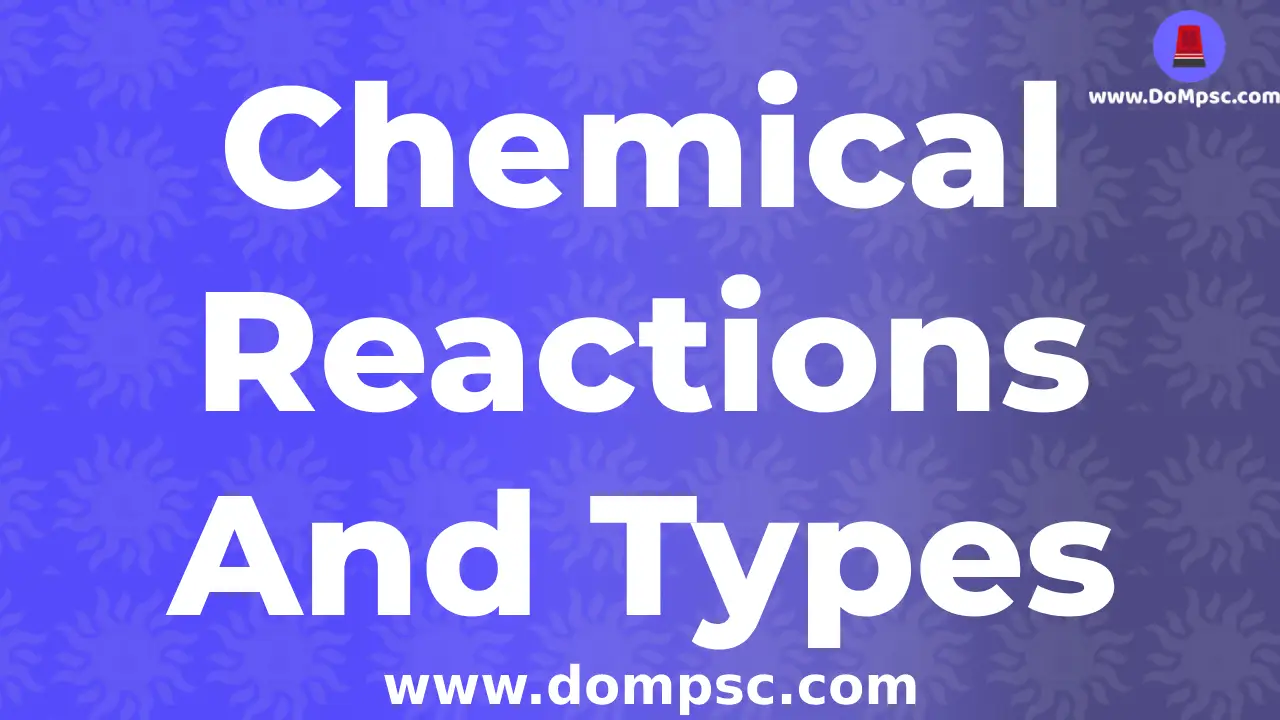Chemical Reactions and its types (रासायनिक अभिक्रिया व त्याचे प्रकार)

✪ Download pdf Works Properly on chrome Browser ✪
Chemical Reactions and its types (रासायनिक अभिक्रिया व त्याचे प्रकार)
Table Of Contain-Chemical Reactions and its types (रासायनिक अभिक्रिया व त्याचे प्रकार)
Intro of Chemical Reactions and its types

By Shubham Vyawahare
16-September-2025
➤It is the acid hydrogen theory, which originated from his collaboration with Friedrich Wilhelm Ostwald in 1884 to establish the existence of ions in aqueous solutions, which led to Arrhenius’s acquisition of the promise in 1903. Bell Prize in Chemistry.
➤Acids and alkali are very important in biology, because most enzymes can only work under a certain acidity.
➤Cells secrete acids and bases to maintain proper pH for enzymes to work
➤Acids and alkali play an important role in the functions of the food you eat to the medicines you take and even the cleaning products you use.
➤Sodium hydroxide which is base used to make soap, paper and rayon. Calcium hydroxide (hydrated lime) is used to produce bleaching powder.
➤Acid and bases can be tested physically by testing a taste of a itom .
➤Acid and bases shows particular chemical reactions.
➤Both can change the physical property while perform on litmus paper taste.
➤Salt in brine is almost always accompanied by chlorides and sulfates of potassium, calcium and magnesium. Carbonate and bromine are also often present. The Dead Sea covers an area of 1,020 square kilometers (394 square miles) and contains approximately 12.65 billion tons of salt..
✪ Acid ✪
➤ Acid is a solution that contain large amount of H+ ions.
➤ In latin language asidus means sour in taste.
➤ An acid is a molecule or ion that can provide protons, or can form a covalent bond with an electron pair
➤Ph range occurs between 1 to 6.99999
➤Ph range occurs between 2 to 3 are very strong acids
➤ Aqueous solutions of acids are electrolytes, meaning that they conduct an electrical current.
➤Acids change the color of certain acid-base indicators
➤Acids react with active metals to yield hydrogen gas
➤Increases the H+ concentration in water.
➤The acid reacts with the base to form a salt compound and water. When equimolar acid and base are combined, the acid is neutralized by the base.
➤Eg.sulfuric acid, hydrochloric acid.
➤The products of this reaction are ionic compounds and water, which are labeled as salts.
✪ Important Acidic Properties ✪
1.Litmus Test-
➤ Blue Litmus paper turn to red
➤ red Litmus paper turn to red
2.phenolphthalein Test-
➤ Acid turn to colorless in acid solution
3.Turmeric Test-
➤ Acid turn to Yellow in solution
4.methyl orange Test-
➤ Acid turn to Pink in acid solution
✪ Base ✪
➤ Acid is a solution that contain large amount of OH ions.
➤ substance that in water solution is slippery to the touch.
➤The Ph range occurs between 7 to 14
➤They are bitter in taste
➤ those bases which are soluble in water are called as Alkaline.
➤ Eg.Ammonia water, sodium hydroxide..
✪ Important Basic Properties ✪
1.Litmus Test-
➤ Blue Litmus paper turn to blue
➤ red Litmus paper turn to blue
2.phenolphthalein Test-
➤ Base turn to Pink in solution
3.Turmeric Test-
➤ Base turn to red in solution
4.methyl orange Test-
➤ Base turn to Yellow in acid solution
✪ Salt ✪
➤ Salt is a mixture of acid and base.
➤there are various form of salts are found on the basis of ration of acid and bases.
➤1.Neutralise salt-Strong Acid + Strong Base
➤2.Acidic Salt-Strong Acid + Strong Base
➤3.Basic Salt-Strong Acid + week Base
➤4.methyl orange Test-Week Acid + Strong Base
| Salt | Uses |
|---|---|
| Sodium Chloride or Common Salt (NaCl) |
|
| Sodium Hydroxide (NaOH) |
|
| Baking Soda or Sodium Bi-carbonate (NaHCO3) |
|
✪ Ph Scale ✪
➤Ph scale discovred by Søren Sørensen, Carlsberg's
➤P h Means Presence of hydrogen in a solution.
➤Ph range from 1 to 14.
➤As Much high H ions in the solution.so that called as acid
➤As Much High OH ions in the solution.so that called as Basic
➤Rain water has ph value 7
➤That means rain water contain same number of hydrogen ion and Oh ions.
✪ Important Ph ✪
| Name | Ph Value |
|---|---|
| Human Blood | 7.35 |
| Saliva | 6.8 |
| Acidic rain | 5.8 |
| Liver Juice | 2 |
| salt | 7.2 |
| Rain Water | 7 |
✪ Acid and base Test ✪
| Name Of Test | Acid | Base |
|---|---|---|
| Litmus Red | Red | Blue |
| Litmus Blue | Red | Blue |
| Phenolphthalein | ColorLess | Pink |
| methylOrange | Pink | Yellow |
| Turmeric | Yellow | Red |
Others Blogs Related to MPSC Chemistry Notes
Read All MPSC blogs
- ➤केंद्र सरकारने खाजगी क्लासेस साठी नवी नियमावली लागू केली आहे |GUIDELINES FOR REGULATION OF COACHING CENTER in marathi
- ➤MPSC Data leak: पेपर न फुटल्याचा दावा MPSC आयोगाने स्पष्टपणे केला आहे
- ➤MPSC hall ticket data leaked before 6 days of exam
- ➤MPSC Data leak: टेलेग्राम वर अचानक ९० हजार परीक्षार्थींचे प्रवेशपत्र झाले लिक
- ➤मराठी भाषेला अभिजात दर्जा मिळायला हवाच , अभिजात दर्जा नेमका कसा मिळतो ?
Download MPSC Books pdf



